A Private Tour today, in NW Norfolk. The plan was to spend the morning up on the Wash, watching the Wader Spectacular, and then the afternoon at Titchwell afterwards. It was cloudy first thing, before starting to brighten up as expected. But we were caught out by a band of heavy rain mid morning which wasn’t in the forecast. At least the sun then cam out in the afternoon and we managed to dry out and enjoy the rest of the day.
As we made our way in to Snettisham, we stopped to look at the gulls on the sailing pit. They were mostly Black-headed Gulls, along with one or two Common Gulls, but we did manage to find a Mediterranean Gull in with them. It was an adult, with pure white wing tips and bright orange-red bill, moulting out of breeding plumage and losing its black hood.
Up on the seawall, there was still lots of exposed mud – we were in good time to watch the waders gathering. A large flock of Oystercatchers was already roosting away to our right along the shore by the sailing club. They wouldn’t be able to stay there long, as it would soon be under water. In front of them, there were lots of Golden Plover and Knot, the former surprisingly hard to see on the mud until we got them in the scope. There were lots of Sandwich Terns gathered on the mud nearby today too.
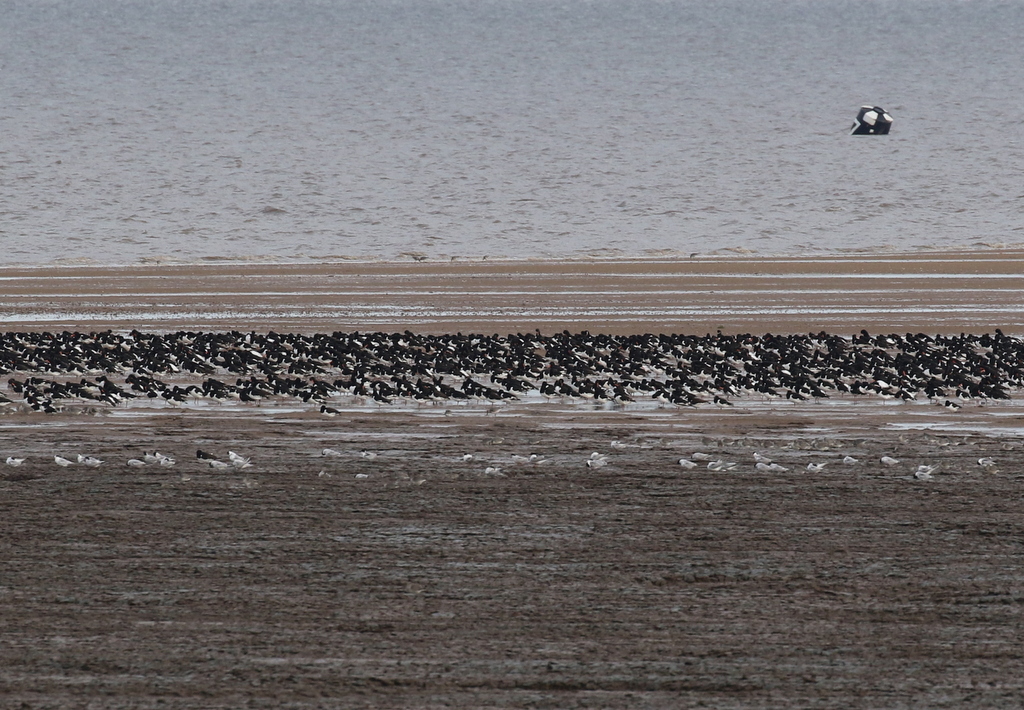
Along the edge of the water, were lots of Black-tailed Godwits. We got them in the scope next and found a single Bar-tailed Godwit in with them, smaller and shorter-legged, still moulting out of breeding plumage with its patchy rusty underparts extending down under the tail. There were lots more Bar-tailed Godwits across the channel, along with more Knot.
We could hear the ‘pooee’ calls of the little groups of Ringed Plover, as they flew in and dropped down onto the mud close to us, in front of the channel. In with them were a few Dunlin and Turnstone, one of the latter still in bright chestnut and pied breeding plumage, as well as one or two Sanderling.
A Curlew Sandpiper appeared down on one of the small pools in front of too – a juvenile, with scaly back, peachy-buff wash across its breast and clean white underparts, as well as a noticeably longer bill than the Dunlin. It disappeared into a channel and we initially thought it was the same bird which then appeared much closer to us. In fact it was a second juvenile Curlew Sandpiper, as the first reappeared back where we had seen it shortly after.
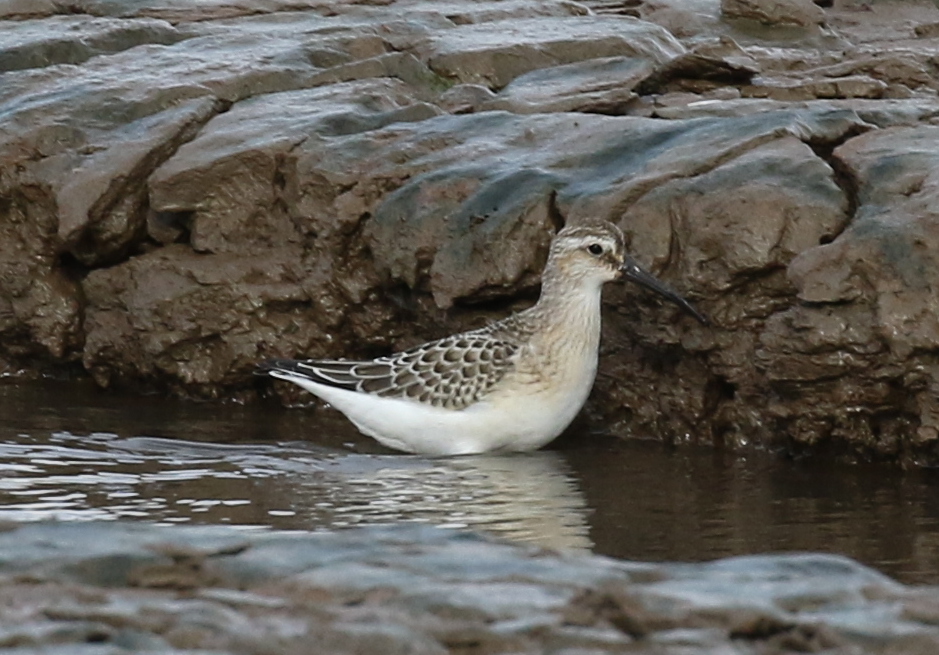
Birds were dropping down on the mud and moving on ahead of the tide all the time. A Spotted Redshank appeared briefly in front of us, staying just long enough for us to get a good look at it through the scope. A single Grey Plover appeared on the mud just across the channel, still sporting the black face and belly of breeding plumage. A Common Sandpiper picked its way past us along the edge of the channel. Three Common Snipe flew past.
It was still rather cloudy at first and little groups of Swallows were passing through, hawking for insects low over the beach. A mixed group of Swallows and House Martins paused for a few minutes in front of us, looking for food around the seawall before moving on. They are on their way south now, heading off to Africa for the winter. We had seen a large gathering of hirundines on the wires as we arrived this morning, presumably having roosted there overnight, so perhaps these same birds were now continuing their journey south.
As the water covered the remaining mud in front of us, the last of the Oystercatchers took off and flew low over the water, across to where the mud was still exposed. We made our way further down that way too. It was finally starting to brighten up now, we could even see some strips of blue sky out over the Wash, coming our way, just as had been forecast.
Down at the corner, opposite the edge of the saltmarsh, we watched as the waders were all pushed up ahead of the tide. The Oystercatchers walked ahead of the rising water, flowing almost like the tide themselves. There were already quite a lot of Knot gathered on the mud, but not the 65,000+ of recent days. That was because a lot of them were still further round the edge of the Wash and gradually they were forced round closer to us, into the last corner of mud which would remain exposed.
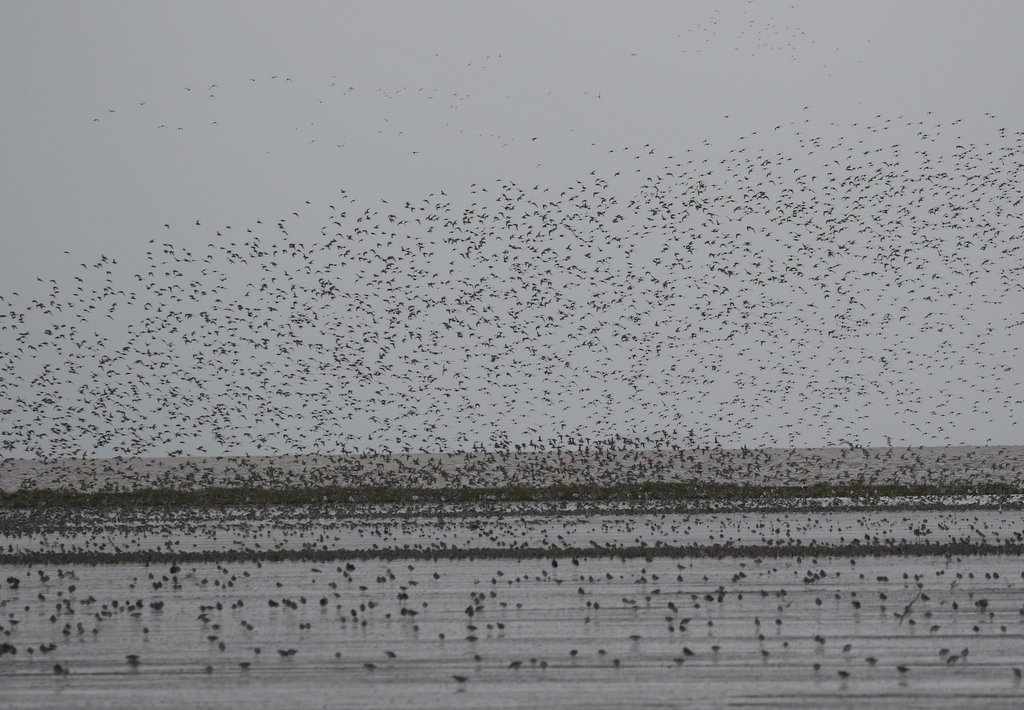
At this point it started to cloud over again and even spit with light drizzle. The forecast had mentioned the chance of a shower, so we were not too worried and continued to enjoy the spectacle. Lots of Curlew and Bar-tailed Godwits were gathering in the grass on the edge of the saltmarsh. As the other waders became increasingly concentrated the Osytercatchers started to give up and peel away in lines, flying past us and dropping down onto the pit behind to roost, piping noisily.
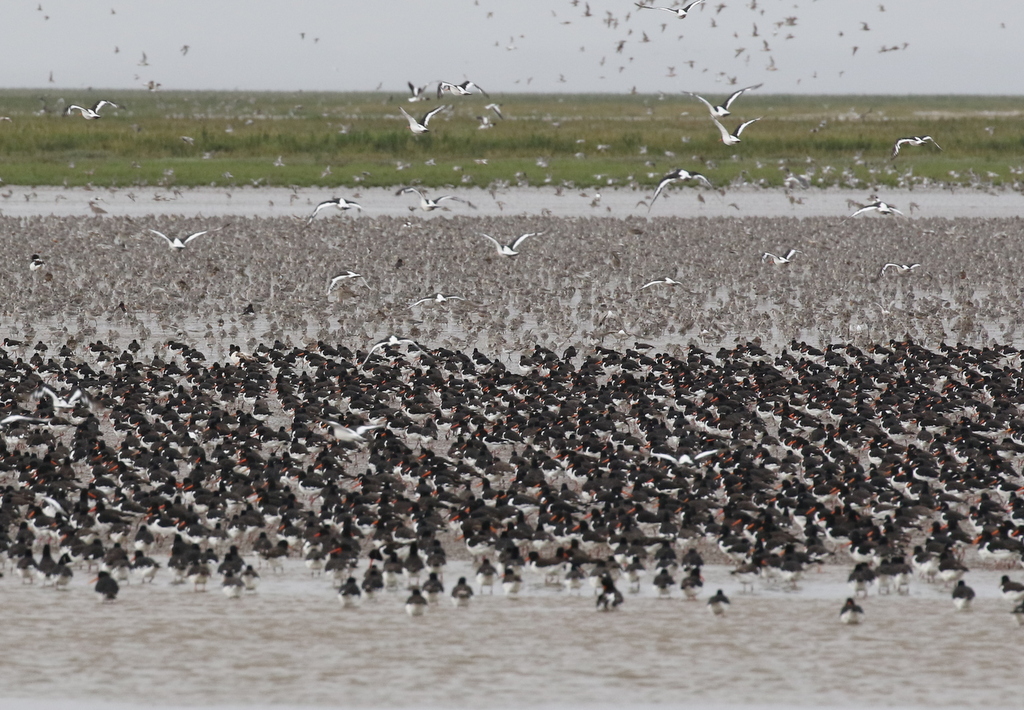
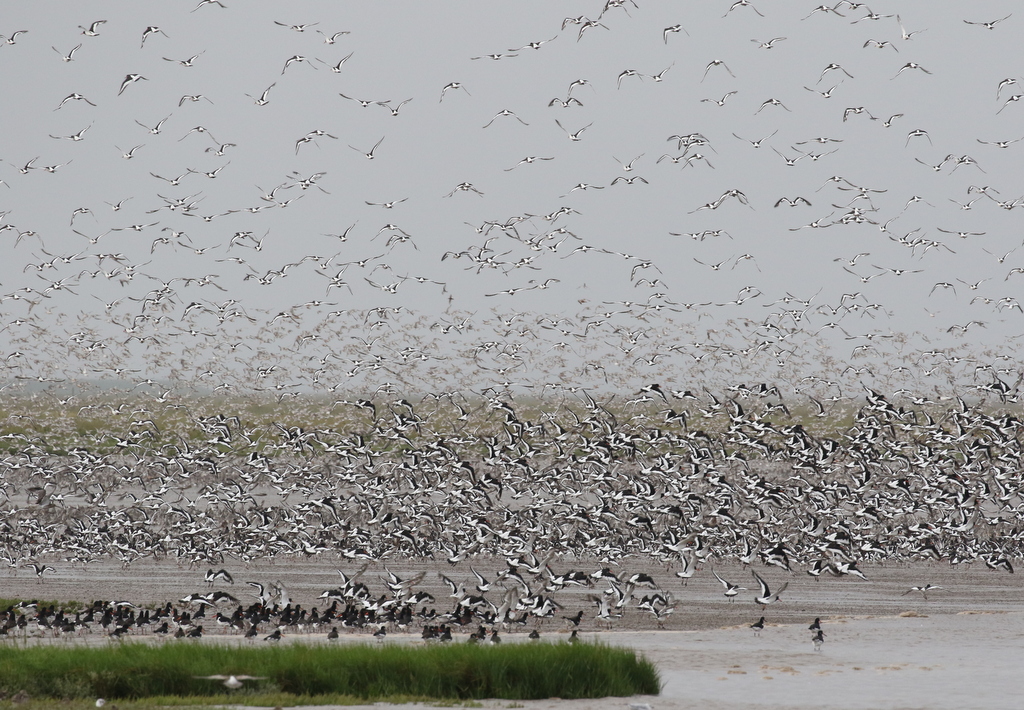
As the Knot became increasingly tightly packed in the corner where the mud was rapidly disappearing, it started to rain more heavily. Just at the wrong moment – this wasn’t in the weather forecast! Most of the other people gathered to watch the spectacle gave up and went into the hides, but with the Knot surely about to take off, we decided to persevere for the finale. But the Knot didn’t leave. It was past the point they would normally take off and they were pressed tight up against the saltmarsh, up to their bellies. They were clearly reluctant to take off given the weather and that seemed to outweigh their normal fear of being so close to or in the vegetation.
The visibility deteriorated as the rain started to fall harder and the wind picked up so, with the Knot refusing to leave, we gave in and walked over to Shore Hide. The hide was fairly busy but at least we were out of the rain. Despite the fact that the Knot were not filling the islands, there were things to see here. A Spoonbill was asleep out in the middle with the Greylag Geese and Cormorants. It did wake up at one point and have a quick preen, when the rain stopped briefly, so we could see its yellow-tipped spoon-shaped bill.
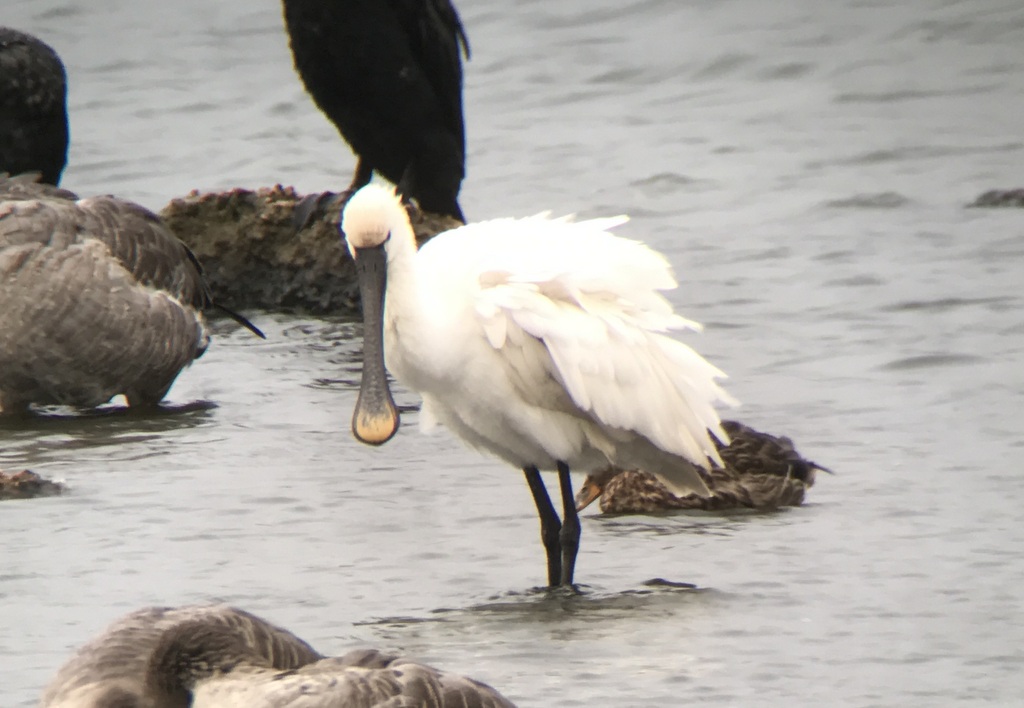
Also in with the geese and Cormorants, we found a small group of Spotted Redshanks. They were much more active today, preening busily when the rain eased off for a time. We counted at least seven today, but there could have been more, hidden in between the geese.

There were lots of Black-tailed Godwits, Redshank and a few Dunlin on the island in front of the hide. The next nearest island out to the left held many more Dunlin today, presumably taking advantage of the absence of many Knot. Looking through them carefully, we found one juvenile Curlew Sandpiper, presumably one of the two we had seen out on the mud earlier.
When the rain eased off, the Knot obviously decided to finally leave the Wash. Large flocks spiralled down onto the islands until they were largely filled, the birds packed in tightly shoulder to shoulder.
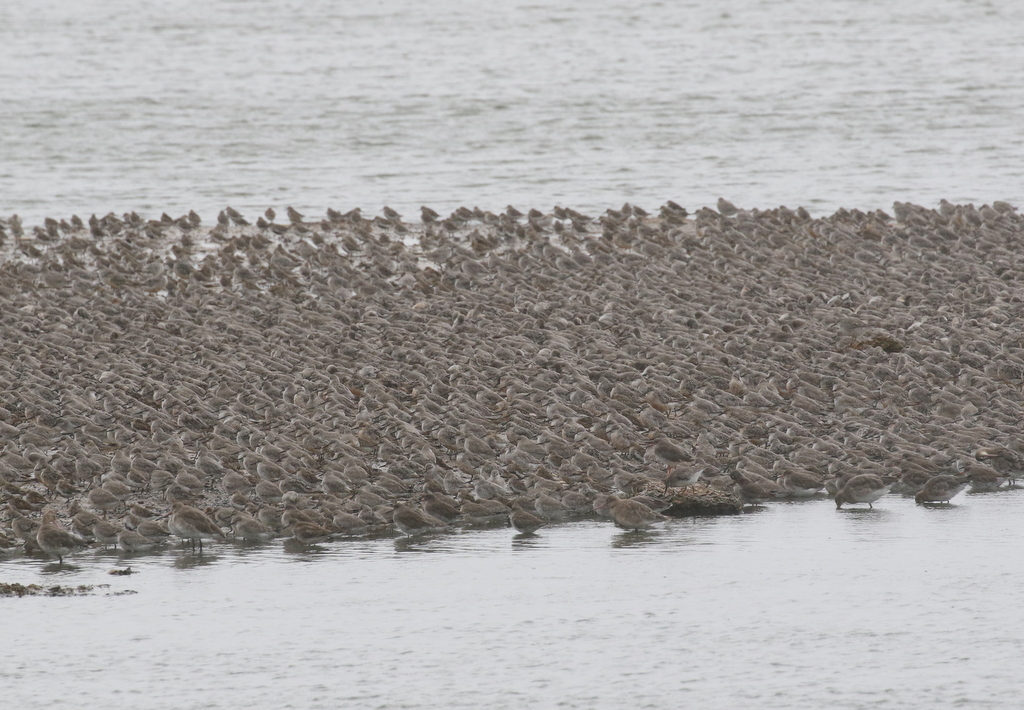
We had hoped to see out the rain in the hide, as we could see from the rainfall radar that it was just a narrow band of cloud passing over us, but it started to rain more heavily again. There seemed to be a series of squalls, easing off and then starting up again, but having got wet people were now starting to get cold and there was a request to head back to the minibus to warm up. We walked back in driving drizzle, getting wet through again, and sure enough we could now see the cloud breaking and a band of blue sky appearing away to the west, heading our way. If only we had been able to hang on another 10 minutes!
We drove round to Titchwell with the heater on full blast which at least started to dry us out. It was dry when we got there and it was already starting to brighten up considerably, but we still stopped for a welcome hot drink at the Visitor Centre. The sun was out by the time we had finished – it felt like a completely different day. We had a bit of time before lunch still, so we decided to walk round to Patsy’s Reedbed and the Autumn Trail.
There were Chiffchaffs calling in the sallows and when we got round to the Tank Road we could see lots of birds in the hedge on the back of the car park. Several of them were coming down to bathe in a small puddle just beyond the gate, Chaffinches, Goldfinches, Greenfinches and Linnets, so we edged over for a closer look.
We looked up in the taller trees to see two Turtle Doves. They were busy preening, presumably come out into the sunshine to dry off. We had a great view of them through the scope, admiring their rusty edged back feathers and black and white striped neck patches.
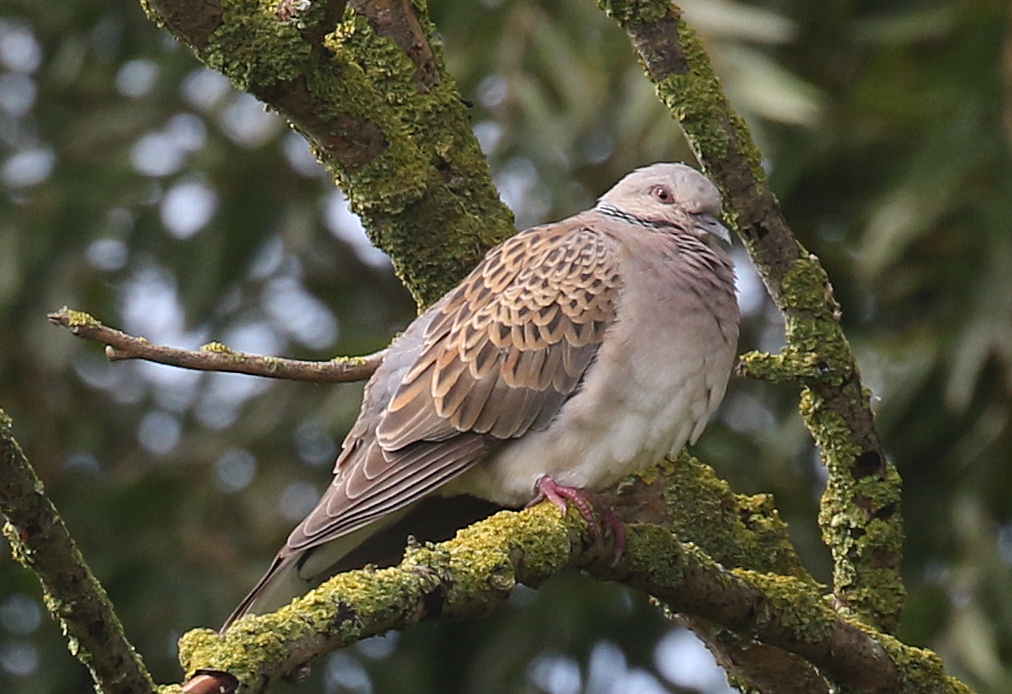
With the UK population having declined by over 90%, it is always a privilege to see Turtle Doves. They will soon be on their way south to Africa for the winter, when they will have to run the gauntlet of shooters in France and Spain, where they are still bizarrely allowed to be shot. Let us hope they can survive the journey and return here next year.
We turned our attention back to the puddle where the birds were bathing, and the bushes beyond. Lots of birds were hoping around on the ground, on the concrete track, including one or two Chiffchaffs and a male Blackcap, as well as the aforementioned finches and several Dunnocks.
There was lots of activity in the hedge the other side too, as a tit flock was working its way through the brambles. As well as the tits, there were a few warblers with them. First a Common Whitethroat appeared in the brambles – we could see its bright rusty-edged wing feathers – then a much greyer bird flew in too, a Lesser Whitethroat. We watched the Lesser Whitethroat feeding on the blackberries in full view for several minutes, great views of this often rather secretive species.
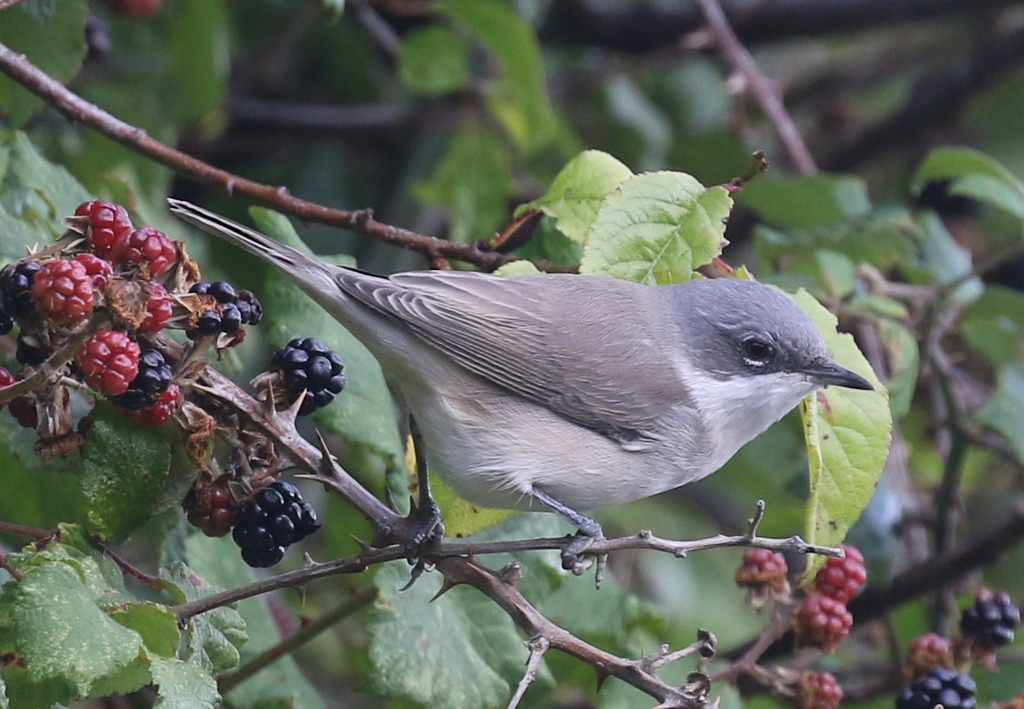
From the screen at Patsy’s Reedbed, we could see lots of ducks out on the water – Gadwall, Mallard, Tufted Duck and Common Pochard, a couple of Teal and a single eclipse drake Wigeon. There were several Little Grebes too, and a pair of Mute Swans with their four well-grown cygnets.
A good number of hirundines were hawking for insects over the pool, mainly Swallows and House Martins, but we found a couple of brown-backed Sand Martins in with them. There were four Swifts zooming back and forth over the reeds beyond too. Most of our Swifts have already left, their brief summer visit here to breed over and these ones were probably passing through, pushed down lower to feed by this morning’s rain with the hirundines.
The Autumn Trail is open new, so we walked on round to the back corner of the Freshmarsh. A flock of Long-tailed Tits came up out of the reedbed and across the path towards Willow Wood as we passed. It was a bit breezy now, so perhaps not surprisingly we did not come across any Bearded Tits here today. There were a few Teal and Ruff on the mud in the corner. More notably, we could see a little group of waders roosting over by the fence on the back of Avocet Island and through the scope we could see they were five Spotted Redshanks with two Black-tailed Godwits.
Then it was back for a late lunch. We found a table in the picnic area in the sun and it was lovely and warm out of the breeze. There were lots of dragonflies buzzing round now – several Migrant Hawkers and a Southern Hawker, and a line of Common Darters sunning themselves on the bench.
After lunch, we headed out onto the reserve. It was a bit breezy as we walked out past the reedbed today. There were a few ducks on the Reedbed Pool, but we headed on out to Island Hide. The juvenile Little Ringed Plover was in exactly the same place we had seen it yesterday, along with a couple of Ringed Plovers still, but there was no sign of the Lapwing which has been right next to the hide in recent days. There were more Ruff over on the edge of the water, but two juveniles gave great views as they fed right outside the windows.
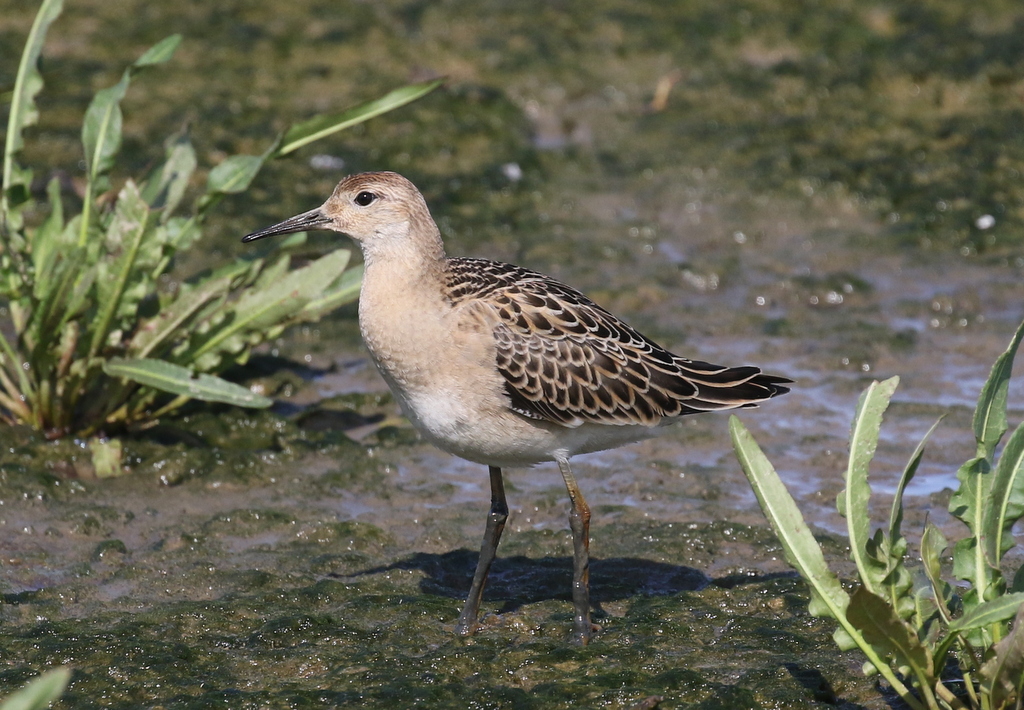
A good sized flock of Dunlin were feeding in the shallow water between here and Parrinder Hide and looking through them we quickly located a juvenile Curlew Sandpiper in with them. A second juvenile Curlew Sandpiper was much further back too.
Scanning along the edge of the reeds, we had a quick view of one juvenile Bearded Tit out on the edge of the mud briefly, but the wind was catching the reeds and they were keeping mostly hidden today. A Water Rail appeared and walked quickly along the edge too before disappearing back in. There were a few Ruff feeding over here as well today, along with a single Knot, possibly the same bird which had been right outside the hide yesterday.
From up on the main path, it didn’t look like there was anything over by Parrinder Hide, so we continued out towards the beach. There was just a single Common Redshank on the near edge of Volunteer Marsh, but scanning down the channel at the far end we found a Curlew, two Black-tailed Godwits, two Grey Plover and a Little Egret. The non-tidal ‘Tidal Pools’ have filled up with water after the recent big high tides, and there was nothing on the one remaining island today.
All the waders were feeding out on the beach, with the tide now out and the mussel beds exposed. There were lots of Oystercatchers, Curlew, Bar-tailed Godwits, Redshank and Turnstones. A couple of small groups of Grey Plover flew in from behind us.
Looking out to sea, we could see a good number of Great Crested Grebes on the water today. Two Fulmars flew in from the west and circled just offshore. But the surprise of the afternoon was a Grey Heron, which we watched working its way in over the sea, well offshore initially. It was probably coming in from Scandinavia for the winter, migration in action!
There were a few gulls on the freshmarsh on our way back, but no sign of the Golden Plover now which had apparently dropped in while we out at the beach. We did find an adult Yellow-legged Gull, next to a much darker-backed Lesser Black-backed Gull, and we could even see its yellow legs before it sat down and went to sleep.
It was time to make our way back now. On the journey home, we stopped to watch a male Marsh Harrier hanging in the wind over a stubble field beside the road, being mobbed by a Carrion Crow. And two Stock Doves in a field were the last addition to the day’s list.
It was a shame about the rain this morning – it had only lasted less than an hour, but just at the wrong moment! Despite that, we had still enjoyed a great day out and seen lots of good birds.
















